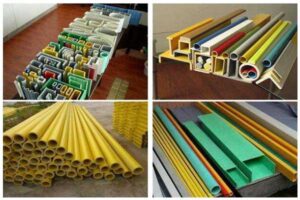FRP is made of glass fiber, resin and other auxiliary materials, it is anti-corrosion, light in weight and maintenance free. However the waste material of fiberglass composites are uneasy to degraded and recycled. With the growing production capacity of the FRP , the deposition and recycle of waste FRP become a hot topic and draw high attention nowadays. There are mainly three methods to recycle the waste FRP products.

Various profiles made of fiberglass
Energy Recycling (incineration method). The energy recovery method is to convert waste (fiber-reinforced composite material) into cement raw materials through a comprehensive method of crushing and burning. In this method, the FRP waste is first crushed into a powder with a particle size of 10 mm, then blown into a cement kiln for combustion as fuel, and the residue can be used as raw material for cement. This method can completely handle the FRP waste. Part of the FRP waste is converted into energy, which can reduce the fuel consumption and reduce carbon dioxide emissions. Due to the high temperature in the kiln, there are very few harmful gases, and there is no problem of harmful gases polluting the air.
Physical Recycling. Crush the FRP waste into powders with different particle sizes and use it as fillers for composites like building materials and thermalplastic. This method is simple, low in cost and has no secondary pollution to the environment. But when manufacturing micropowder, the crushing cost is relatively high. When adding those micropowder to BMC, SMC or other FRP products, the strength of new products is reduced as the amount of addition increases.
Chemical Recycling. This method is to pyrolyze the FRP waste in an oxygen-free or even ultra-high vacuum environment, and to decompose the waste into unsaturated polyester raw materials, glass fibers, and fillers. Unsaturated polyester raw materials and fiberglass can be used to remake FRP profiles, fillers can be used for agricultural fertilizers to balance the acidity and alkalinity of the land, and can also be used as raw materials for composite materials. In this way, the renewable utilization of FRP waste is achieved, which greatly reduces environmental pollution. So far chemical recovery method is considered to be the most promising recycling technology.
 info@unicomposite.com
info@unicomposite.com


























